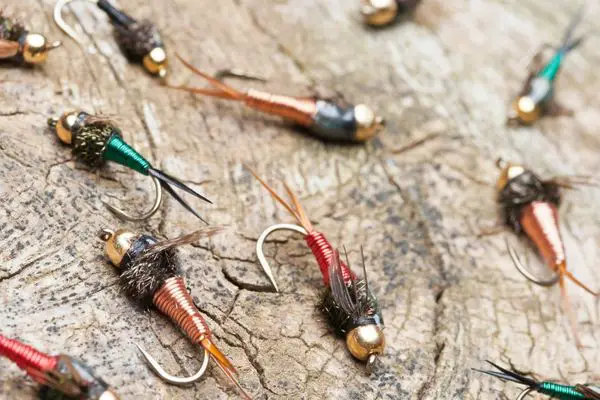When out try fishing, most of the trout we see are feeding close to the surface, maybe sipping down mayflies. Sometimes, they have laying in the shallows, drifting side to side intercepting any nymph that floats by.
These trout that we see in shallow water are the exception rather than the rule. For most of the day, the majority of trout live and feed low in the water column, often hugging the bottom. It is safe down there, out of the current and they do not have to worry about attacks from below. All that water overhead also provides good defense against birds of prey. They can also lay there and watch any morsel float by, popping up from time to grab to swallow a tasty stonefly or drifting caddis.
So it is not surprising, that trout spend most of their time lower rather than higher in the water column. To have the best chance of catching these fish, we have to get our flies down to where they are. Trout are lazy fish, they are not going to spend any more energy than absolutely necessary. If your nymph is floating three feet above their heads it is probably not worth the effort, if it is floating an inch away, then down it goes.
The nine main ways to sink flies
Generally speaking, there is nine main ways or techniques that can be used to get a fly down deeper. I will discuss them in more detail below.
1) Adding weight causes flies to sink
I will start with the most obvious solution, which is to add weight. This can be done in a number of flies, many fishermen will use a heavier fly. This could be one with extra wraps of lead or the addition of a tungsten bead or two.
It is also possible to add weight to the fly line itself, that is what sinking fly lines are. They are fly lines that are heavier so they sink. A heavy fly line, will pull the flies down with it.
One other variation is to use a multi fly rig, have one heavy fly which is designed to sink fast, and a smaller lighter fly that represents what the trout are feeding upon. The heavy fly will pull the lighter fly down.
The final way to add weight might just be the most simple. It is to add weight to the leader or tippet, this is usually in the form of split shot, but in some more turbulent water dropshot sinkers can be used.
But adding weight has a downside, heavy flies become cumbersome to cast, and a heavy nymph does not dance naturally with the current but gets dragged towards the bottom. We often talk about drag free presentation, a heavy nymph or even sinking fly creates its own downwards drag. This can be off putting to trout. Trout typically expect to see nymphs raising towards the surface, not sinking to the bottom.
2) Thinner leader and tippet sink faster, and creates less drag
This one is a bit complicated because there is many opposing forces at play.
A thinner line has less surface area, making it less buoyant but it also has less mass making it more likely to float. So how do these two forces cancel each other out?
Will, it is the drag of the current pushing against the line, rather than the weight of the line itself that influences the movement of the fly. So the reduction of surface area on the thinner leader means it will sink faster than the thicker leader. This becomes even more apparent when a weighted nymph is pulling them down.
So it takes a heavier nymph to break the surface tension and pull a thick 1x or 2x leader under than it would take to pull a thin 5x or 6x under. So using a thinner leader, with the same weight of the fly, will sinker faster than a thicker leader.
Will how about monofilament, doesn’t mono float? No, once the surface tension has been broken both monofilament and fluorocarbon sinks. Mono is not positivity buoyant.
3) Reduce the bulk of flies
Another way to get a fly to sink faster is to make them more streamlined, less bulky. Reduce their surface area.
So the smaller the surface area of a fly, the faster it will sink. A tightly tied pheasant tail despite being the same approximate weight as a bulky beetle fly will sink simply due to its lack of surface area.
So the best sinking nymphs, are tight and streamlined with minimal dangling wiggly bits.
4) Longer leaders allow for deeper drifts
The length of line you are fishing determines how deep a fly can go. If your leader is only 4ft long, it can only get down about 4ft, if you are fishing a 9ft leader, then it can get down about 9ft.
Okay, this is not an exact science, and the entire length of the leader is not going to be sinking vertically in the water column, but they angle down, but the principle still holds, a longer leader allows for deeper drifts.
5) Present upstream to allow for deeper drifts down
Flies do not sink instantly, they slowly fall towards the bottom. So the further upstream a nymph is presented the longer it has to sink towards the bottom.
Increasing the amount of time a nymph is allowed to drift for, will nearly always guarantee a deeper presentation. The compromise is casting fat enough upstream to maximize the time the nymph has to sink, but without covering the trout with the fly line itself.
When trying to fish deep, do not handicap yourself by placing an indicator (or hopper) too close to the nymph.
6) Keep the fly line off the water
When fishing a floating fly line, the fly line itself is influenced by the current creating drag, which will in turn pull the nymph towards the surface. Try and keep as little fly line on the water at any time, this minimizes drag allowing the nymph to sink faster.
7) Strike indicators limits the potential depth
The placement of a strike indicator or float can also determine how deep a fly is going to get. Moving the indicator closer to the nymph will force the nymph to stay closer to the surface. Moving the indicator closer to the butt of the fly line, will allow the nymph to get down deeper.
If you have very good control over your presentation, it is actually possible to fish without a strike indicator, this further reduces any chance of drag.
8) Use a large weighted to bring down a small nymph
So the trout are eating size 20 nymphs, but the water is simply too turbulent to get such a finesse fly into the strike zone. Will, it is possible to use a two fly rig.
One heavy fly that sinks quickly into the strike zone, and a second lighter fly which represents what the trout are eating on. This way, it is possible to present what the trout.
9) Try and avoid crossing current seams
Rivers flow at various speeds across their width, and some seams flow faster than others, when presenting the fly it is best to try and keep the fly and leader in the same seam. The fly line crossing several seams can greatly increase the amount of drag forcing the fly back towards the surface.
BY keeping the presentation within a single seam, it maximizes the chances of it getting down deep because both the fly and the line will be moving at a comparable speed.

